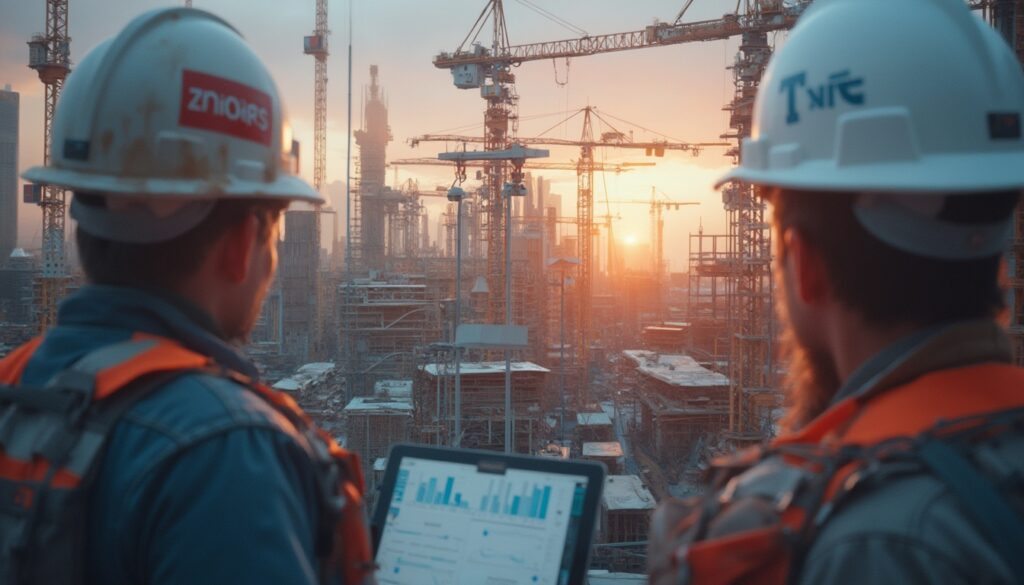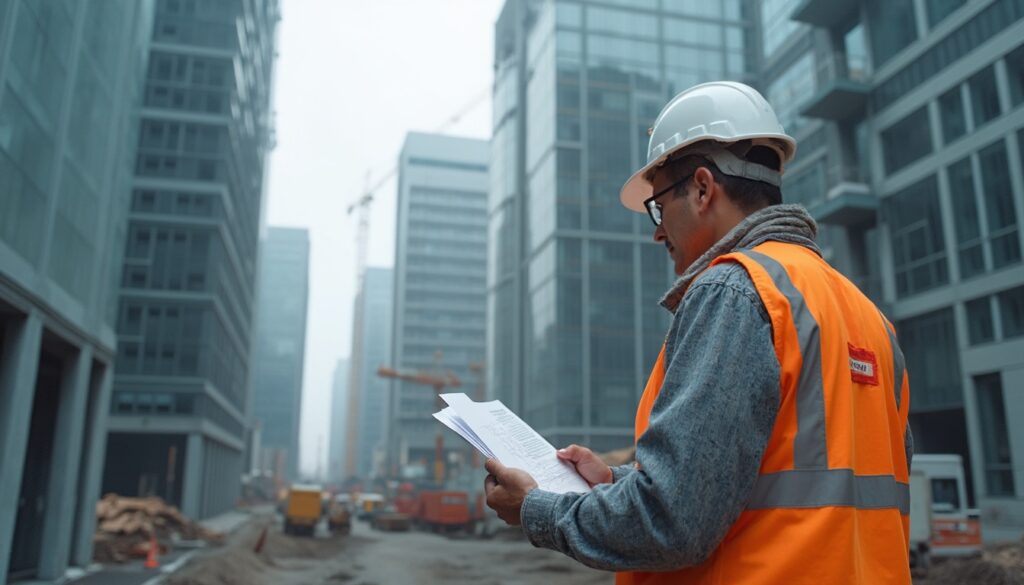Phase 1: Planning and Preparation (LPH 1-5)
The planning phase lays the foundation for overall project success and includes the HOAI performance phases 1 to 5. Here, over 70% of the future construction costs are already determined. A precise determination of basics (LPH 1) and a clean approval planning (LPH 4) are crucial. During this phase, all execution documents must be free of defects and available on time according to § 3 VOB/B to avoid delays. Often, the central availability of these documents for all trades fails.
With Valoon, you ensure that all plans and documents are sent to the respective teams with a click and changes are communicated in real time. Instead of searching through 5 different email threads for the final version, every employee has the current plans directly on hand via WhatsApp. This reduces inquiries by up to 40%. This early and clear communication is an important part of the tasks of construction supervision. This creates a solid basis for the subsequent shell construction phase.
Phase 2: The Shell Construction – The Skeleton of Your Project (LPH 8)
The shell construction phase is the most visible stage of construction and falls within performance phase 8 (object monitoring). Here, the foundations for the stability and safety of the entire building are laid. Continuous documentation of construction progress is now essential. A construction log that records the state of the construction site, the present workers, and the work performed is not just a recommendation but often contractually required. A missing entry can mean the loss of evidence in later defect claims.
Creating a construction log often costs site managers more than 45 minutes per day. Valoon automates this process: photos, notes, and voice messages from the construction site are sent via WhatsApp and automatically summarized in a legally secure construction report. This not only saves time, but also ensures compliance with the VOB in case of damages during the construction phase. The following checklist helps you keep track during the shell construction:
- Construction site setup: Is access secured and are all necessary connections (water, electricity) functional?
- Earthworks & Foundation: Was the soil analysis taken into account and was the ground slab poured correctly?
- Masonry & Concrete Work: Does the execution comply with the execution plans and the statics?
- Floor slabs: Have all reinforcements and recesses been correctly placed?
- Roof structure: Is the timber installed professionally and protected against the weather?
A clean documentation of these points is crucial before the interior construction begins and many components become concealed.
Phase 3: The Interior Construction – Coordination of Trades
In interior construction, often more than 10 different trades work in parallel on the construction site. The coordination of these teams is one of the greatest challenges for construction management. According to an analysis, interface problems between the trades can lead to delays of up to 20% of the total construction time. Here, clear and traceable communication is vital. Every instruction, every approval, and every defect report must be documented.
Imagine the electrician has a question about the location of a switch. Instead of calling the site manager, who may be in a important construction meeting , he sends a photo with a voice message via Valoon. The information is immediately documented, timestamped, and can be forwarded directly to the planner. This type of asynchronous communication increases efficiency by at least 15%. The following points are particularly critical in interior construction:
- Building services (heating, plumbing, electrical): Are all lines installed according to the final plans, and pressure tests conducted?
- Screeding and Plastering: Are the drying times observed before subsequent work begins? A common mistake that leads to construction damages.
- Window and Door Installation: Is the installation airtight and done according to the manufacturer’s specifications?
- Drywall: Are all walls correctly erected and jointed?
- Flooring and Painting Work: Is the substrate prepared and have the previous trades been passed?
A precise control of these steps prevents expensive corrections and lays the foundation for a successful acceptance.
Phase 4: The Construction Acceptance – Legal Security at the Finale (LPH 9)
The construction acceptance after § 12 VOB/B is the decisive legal step, where the risk transfers to the client and the warranty periods begin. Incomplete documentation can have fatal consequences here. Without seamless proofs, it is almost impossible to clearly assign the cause of a defect and enforce claims. A study shows that over 50% of all disputes in construction are due to defects and their unclear documentation.
With Valoon, you have all the necessary documents at hand for acceptance. Every photo, every note, and every protocol is stored chronologically and sorted by component in the system. This way, you can access each defect immediately with the entire history during the inspection and create a legally secure protocol for the legal construction acceptance . This gives you the security you need for a successful project completion. Performance phase 9 (object supervision) begins after acceptance and includes monitoring the rectification of defects. Here too, a clean data basis supports you in keeping an eye on the limitation periods. Thus, a stressful duty exercise becomes an orderly process.
Conclusion: Your Advantage with Valoon
A detailed checklist for the construction phase is the first step towards more structure and less stress. But only a digital tool that is accepted by all employees brings this structure to life in daily operations. Valoon bridges the gap between office and construction site by using everyday communication via WhatsApp to automatically create a legally secure documentation . You benefit from enormous time savings in creating construction logs and a seamless chain of evidence in case of defect claims. Ensure clear processes and minimize your risk. Book your free demo now and experience how easy digital construction documentation can be.
More Links
Wikipedia provides a comprehensive overview of construction acceptance, a crucial step in construction projects.
Construction Ministers’ Conference provides a PDF document that contains relevant information on building regulations and guidelines.
Federal Institute for Occupational Safety and Health (BAuA) offers a publication in collaboration with the BIBB that addresses important facts and insights on occupational safety.
Federal Institute for Occupational Safety and Health (BAuA) informs about figures, data, and facts related to fatal work accidents in Germany.
German Statutory Accident Insurance (DGUV) provides a publication with important information on statutory accident insurance and accident prevention.
German Institute for Standardization (DIN) provides a press release on quality infrastructure that supplies questions and answers to it.
German Institute for Standardization (DIN) offers a PDF document with the latest standards for buildings (NRM Buildings 2024).
FAQ
Which documents are the most important in the construction phase?
The most important documents include the building permit, execution plans, the construction log, minutes of construction meetings, delivery notes, evidence of material tests, and the acceptance protocol. A central and digital storage of these documents is essential.
How can I improve communication on the construction site?
Use a central, simple communication channel that is accepted by all. Valoon uses WhatsApp to directly document instructions, photos, and defect reports. This prevents information loss and ensures everyone is on the same page.
What is the difference between HOAI and VOB?
The HOAI (Fee Structure for Architects and Engineers) regulates which services planners provide in the 9 performance phases and how these are compensated. The VOB (Procurement and Contract Regulations for Construction Services) is a framework for the procurement and handling of construction contracts and governs the contractual relationship between the client and contractor.
How do I create a legally secure construction log?
A legally secure construction log must be maintained daily and document all significant events without gaps. This includes date, weather, present persons, work performed, materials used, special occurrences, and defects. Digital solutions like Valoon automate this process and ensure unalterable, timestamped entries.
Who is responsible for site safety?
Basically, the client is responsible for safety on the construction site. However, he can delegate this task to a site manager or a safety and health protection coordinator (SiGeKo). Compliance with regulations must be regularly monitored and documented.
How long must construction documents be kept?
Retention periods vary. For defect claims under VOB/B, the period is generally 4 years. Tax-relevant documents must be kept for 10 years. For load-bearing components, the period can be up to 30 years. Digital archiving facilitates compliance with these periods.








